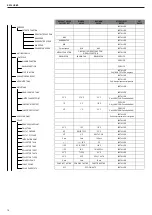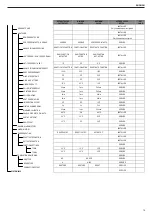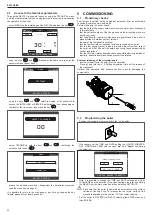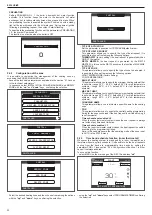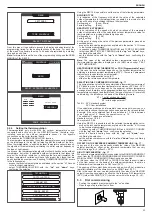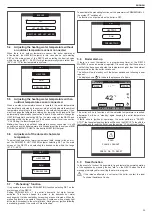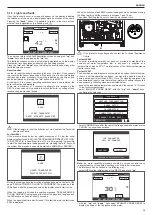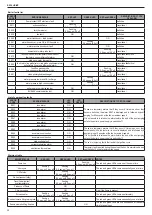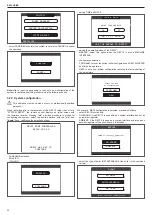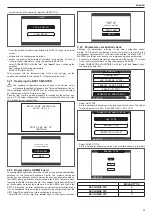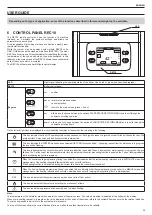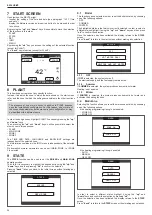
23
ENGLISH
SETTINGS
MENU
SELECT OPTION
TIME SCHEDULE
TIME SCHEDULE
SETTINGS
MENU
SELECT OPTION
From this menu it is possible to access the display and adjustment of the
programming timing for the heating functions of the zone. For each day
of the week it is possible to set up to 4 bands, characterised by a starting
time and an end time.
Note:
for more details on the use of the programming timing see the USER
MANUAL of the REC10.
MON
18/11/2013
12:17
MAIN
SELECT THE ZONE
SCHEDULE
SCHEDULE
MAIN
RESET ATTEMPTS EXHAUSTED
MON
07:30
11:30
18:00
08:30
13:30
22:30
SELECT
A DAY
START
MAIN
THURSDAY
END
ZONE SCHEDULE
START
END
MAIN
THURSDAY
ZONE SCHEDULE
SELECT A DAY
5.2.4 Setting the thermoregulation
Thermoregulation only works with the outdoor temperature sensor
connected and active only for the HEATING function; therefore, once
installed, connect the outdoor temperature sensor to the specific
connections on the boiler terminal board.
This enables the THERMOREGULATION function.
The temperature measured by the outdoor temperature sensor is displayed
on the initial page in the top right, alternating with the display of the time.
When thermoregulation is enabled (outdoor temperature sensor present),
the algorithm for automatically calculating the outlet setpoint depends on
the type of heat request.
In any case, the thermoregulation algorithm will not directly use the outdoor
temperature, but rather a calculated outdoor temperature that takes into
account the building’s insulation: in buildings that are well insulated, the
outdoor temperature variations will have less impact than those that are
poorly insulated by comparison. Enabling THERMOREGULATION occurs
in the following way:
- access the technical parameters as explained in the section
- select THERMOREGULATION with the
“up”
and
“down”
keys,
confirming the selection.
PARAMETERS
THERMOREGULATION
RANGE RATED
TECHNICAL
INSTALLER
CALIBRATION
INSTALLATION
RANGE RATED
WEATHER COMPENSATION
PARAMETERS
INSTALLATION
CALIBRATION
TECHNICAL
INSTALLER
Using the REC10 it is possible to set the value of the following parameters:
BUILDING TYPE
It is indicative of the frequency with which the value of the calculated
outdoor temperature for thermoregulation is updated, a low value for this
value will be used for buildings that have little insulation.
Setting range:
[5min - 20min]
Factory setting:
[5min]
REACTIVITY EXT SENSOR
It is an indication of the speed with which variations of the measured
outdoor temperature affect the calculated outdoor temperature value for
thermoregulation, low values indicate high speeds.
Setting range:
[0 - 255]
Factory setting:
[20]
At this point, to change the value of the previous parameters, proceed as
described below:
- access the technical parameters as explained in the section
- in sequence select THERMOREGULATION and TYPE OF BUILDING
rather than REACTIVITY EXT SENSOR with the
“up”
and
“down”
keys,
confirming the selection
- set the desired value with the
“up”
and
“down”
keys, confirming the
selection.
Note:
The value of the calculated outdoor temperature used by the
thermoregulation algorithm is displayed in the INFO menu under T EXT
FOR THERMOREG.
HEAT REQUEST FROM THERMOSTAT or POR (Programmable Timer)
In this case the outlet setpoint depends on the outdoor temperature for
obtaining a reference ambient temperature of 20°C. There are 2 parameters
that compete to calculate the output setpoint:
- slope of the compensation curve (KT)
- offset on the reference ambient temperature.
SELECTING THE COMPENSATION CURVE- fig. 17
The compensation curve for heating maintains a theoretical temperature of
20°C indoors, when the outdoor temperature is b20°C and -20°C.
The choice of the curve depends on the minimum outdoor temperature
envisaged (and therefore on the geographical location), and on the delivery
temperature envisaged (and therefore on the type of system). It is carefully
calculated by the installer on the basis of the following formula:
KT = T. outlet envisaged - Tshift
20- min. design external T
Tshift = 30°C standard system
25°C floor installations
If the calculation produces an intermediate value between two curves, you
are advised to choose the compensation curve nearest the value obtained.
Example: if the value obtained from the calculation is 1.3, this is between
curve 1 and curve 1.5. Choose the nearest curve, i.e. 1.5.
The settable KT values are as follows:
standard system: 1.0-3.0
floor system 0.2-0.8.
Using the REC10 it is possible to set the selected thermoregulation curve:
- access the technical parameters as explained in the section
- in sequence select THERMOREGULATION and CLIMATIC CURVES
with the
“up”
and
“down”
keys, confirming the selection
- select the desired heating zone with the
“up”
and
“down”
keys,
confirming the selection
- set the desired climatic curve with the
“up”
and
“down”
keys, confirming
the selection.
OFFSET ON THE REFERENCE AMBIENT TEMPERATURE - fig. 17
In any event, the user can indirectly modify the value of the HEATING
setpoint inserting an offset on the reference temperature that can vary
within the range -5-+5 (offset 0 = 20°C).
NIGHT COMPENSATION - fig. 17
Whenever a programmable timer is connected to the ROOM THERMOSTAT
input, from the TECHNICAL\THERMOREGULATION\CLIMATIC CURVES\
MAIN the NIGHT COMPENSATION function can be enabled.
In this case, when the CONTACT is CLOSED, the heat request is made
by the flow sensor, on the basis of the outdoor temperature, to obtain a
nominal ambient temperature on DAY level (20°C).
The opening of the contact does not produce a switch-off, but a reduction
(parallel translation) of the climatic curve on NIGHT level (16°C).
Also in this case, the user can indirectly modify the value of the HEATING
setpoint inserting once again an offset on the reference DAY temperature
(20°C) rather than NIGHT (16°C) that can vary within the range [-5 - +5].
5.3 First commissioning
- Position the system’s master switch to the “on” position.
- Open the gas tap to allow fuel to flow.
Summary of Contents for EXCLUSIVE C
Page 101: ... ...










